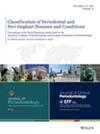Concentrated growth factor with guided tissue regeneration for shallow infrabony defects: A one-year prospective study.
IF 3.8
2区 医学
Q1 DENTISTRY, ORAL SURGERY & MEDICINE
引用次数: 0
Abstract
BACKGROUND This study evaluated the efficacy of concentrated growth factor (CGF) sticky bone combined with guided tissue regeneration (GTR) in treating shallow infrabony defects and explored factors influencing clinical outcomes. METHODS Thirteen patients with 31 shallow defects (≤3 mm) were treated using CGF sticky bone (CGF + deproteinized bovine bone mineral), covered with a collagen membrane and CGF membrane. Probing depth (PD), clinical attachment level (CAL), and gingival recession (REC) were examined at baseline and 1 year post surgery. The distance between the base of the defect and the cementoenamel junction (BD-CEJ) were measured on periapical radiographs. Gingival volume and thickness were assessed with digital intraoral scans. Linear regression identified factors influencing CAL gain, PD reduction, and bone gain (ΔBD-CEJ). RESULTS One year post surgery, CAL increased by 2.48 ± 1.72 mm (p < 0.001), PD reduced by 2.90 ± 1.40 mm (p < 0.001), and bone gain was 2.46 ± 1.71 mm (p < 0.001). REC remained stable (p = 0.254), and the volume and thickness of gingival contour showed no significant changes (p = 0.751 and p = 0.915, respectively). Greater baseline attachment loss was associated with higher CAL gain (coefficient 0.436, p = 0.001). Deeper preoperative PD predicted greater PD reduction (coefficient 0.573, p = 0.029). Greater bone gain was correlated with lower baseline bone height (coefficient 0.305, p = 0.018). CONCLUSIONS CGF sticky bone combined with GTR demonstrates benefits in CAL gain, PD reduction, and bone gain while preventing REC and gingival contour collapse in the treatment of shallow infrabony defects with residual pockets after initial therapy. CLINICAL TRIAL REGISTRATION Chinese Clinical Trial Registry (ChiCTR2300069617). PLAIN LANGUAGE SUMMARY This study explored a novel approach to treating shallow bone defects around teeth using a combination of concentrated growth factor (CGF) sticky bone and guided tissue regeneration (GTR). The treatment involved using a specially prepared bone graft material (CGF sticky bone) along with a collagen membrane and a CGF membrane. The researchers tracked the changes in gum and bone health in 13 patients with 31 shallow defects over 1 year. The results showed significant improvements: Gum attachment levels increased by an average of 2.48 mm, gum pockets reduced by 2.90 mm, and bone growth averaged 2.46 mm. Notably, gum recession and gingival contour remained stable, meaning the treatment did not compromise the appearance of the gums. The study also found that patients with worse gum or bone loss at the start of the treatment tended to experience the greatest improvements. These findings suggest that CGF sticky bone combined with GTR is a promising option for restoring shallow bone defects, particularly in cases where traditional therapy has left residual gum pockets.浓缩生长因子引导下组织再生治疗浅下骨缺损:一项为期一年的前瞻性研究。
本研究评价了浓缩生长因子(CGF)黏性骨联合引导组织再生(GTR)治疗浅下骨缺损的疗效,并探讨了影响临床疗效的因素。方法采用CGF黏性骨(CGF +脱蛋白牛骨矿物质),覆盖胶原膜和CGF膜,治疗13例31处(≤3mm)浅层缺损。在基线和术后1年检查探入深度(PD)、临床附着水平(CAL)和牙龈退缩(REC)。在根尖周围x线片上测量缺损基部与牙髓-牙釉质交界处(BD-CEJ)之间的距离。通过数字口内扫描评估牙龈体积和厚度。线性回归确定了影响CAL增加、PD减少和骨增加的因素(ΔBD-CEJ)。结果术后1年CAL增加2.48±1.72 mm (p < 0.001), PD减少2.90±1.40 mm (p < 0.001),骨增重2.46±1.71 mm (p < 0.001)。REC保持稳定(p = 0.254),牙龈轮廓的体积和厚度无显著变化(p = 0.751和p = 0.915)。更大的基线依恋损失与更高的CAL增益相关(系数0.436,p = 0.001)。术前PD越深,PD降低程度越高(系数0.573,p = 0.029)。骨增重越大,基线骨高越低(系数0.305,p = 0.018)。结论scgf黏性骨联合GTR在治疗初期伴有残囊的浅下骨缺损时,具有CAL增加、PD减少和骨增加的优点,同时可防止REC和牙龈轮廓塌陷。中国临床试验注册中心(ChiCTR2300069617)。摘要本研究探讨了一种结合浓缩生长因子(CGF)黏性骨和引导组织再生(GTR)治疗牙周浅层骨缺损的新方法。治疗包括使用特殊制备的骨移植材料(CGF粘骨)以及胶原膜和CGF膜。研究人员在一年多的时间里追踪了13名有31个浅缺陷的患者牙龈和骨骼健康的变化。结果显示了显著的改善:牙龈附着水平平均增加了2.48毫米,牙龈袋减少了2.90毫米,骨生长平均为2.46毫米。值得注意的是,牙龈萎缩和牙龈轮廓保持稳定,这意味着治疗没有损害牙龈的外观。研究还发现,在治疗开始时牙龈或骨质流失更严重的患者往往会经历最大的改善。这些发现表明,CGF粘骨联合GTR是修复浅层骨缺损的一种很有希望的选择,特别是在传统治疗留下残余牙龈袋的情况下。
本文章由计算机程序翻译,如有差异,请以英文原文为准。
求助全文
约1分钟内获得全文
求助全文
来源期刊

Journal of periodontology
医学-牙科与口腔外科
CiteScore
9.10
自引率
7.00%
发文量
290
审稿时长
3-8 weeks
期刊介绍:
The Journal of Periodontology publishes articles relevant to the science and practice of periodontics and related areas.
 求助内容:
求助内容: 应助结果提醒方式:
应助结果提醒方式:


